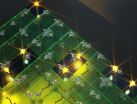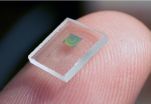(Press-News.org) In what marks a significant step forward for artificial intelligence, researchers at UC Santa Barbara have demonstrated the functionality of a simple artificial neural circuit. For the first time, a circuit of about 100 artificial synapses was proved to perform a simple version of a typical human task: image classification.
"It's a small, but important step," said Dmitri Strukov, a professor of electrical and computer engineering. With time and further progress, the circuitry may eventually be expanded and scaled to approach something like the human brain's, which has 1015 (one quadrillion) synaptic connections.
For all its errors and potential for faultiness, the human brain remains a model of computational power and efficiency for engineers like Strukov and his colleagues, Mirko Prezioso, Farnood Merrikh-Bayat, Brian Hoskins and Gina Adam. That's because the brain can accomplish certain functions in a fraction of a second what computers would require far more time and energy to perform.
What are these functions? Well, you're performing some of them right now. As you read this, your brain is making countless split-second decisions about the letters and symbols you see, classifying their shapes and relative positions to each other and deriving different levels of meaning through many channels of context, in as little time as it takes you to scan over this print. Change the font, or even the orientation of the letters, and it's likely you would still be able to read this and derive the same meaning.
In the researchers' demonstration, the circuit implementing the rudimentary artificial neural network was able to successfully classify three letters ("z", "v" and "n") by their images, each letter stylized in different ways or saturated with "noise". In a process similar to how we humans pick our friends out from a crowd, or find the right key from a ring of similar keys, the simple neural circuitry was able to correctly classify the simple images.
"While the circuit was very small compared to practical networks, it is big enough to prove the concept of practicality," said Merrikh-Bayat. According to Gina Adam, as interest grows in the technology, so will research momentum.
"And, as more solutions to the technological challenges are proposed the technology will be able to make it to the market sooner," she said.
Key to this technology is the memristor (a combination of "memory" and "resistor"), an electronic component whose resistance changes depending on the direction of the flow of the electrical charge. Unlike conventional transistors, which rely on the drift and diffusion of electrons and their holes through semiconducting material, memristor operation is based on ionic movement, similar to the way human neural cells generate neural electrical signals.
"The memory state is stored as a specific concentration profile of defects that can be moved back and forth within the memristor," said Strukov. The ionic memory mechanism brings several advantages over purely electron-based memories, which makes it very attractive for artificial neural network implementation, he added.
"For example, many different configurations of ionic profiles result in a continuum of memory states and hence analog memory functionality," he said. "Ions are also much heavier than electrons and do not tunnel easily, which permits aggressive scaling of memristors without sacrificing analog properties."
This is where analog memory trumps digital memory: In order to create the same human brain-type functionality with conventional technology, the resulting device would have to be enormous -- loaded with multitudes of transistors that would require far more energy.
"Classical computers will always find an ineluctable limit to efficient brain-like computation in their very architecture," said lead researcher Prezioso. "This memristor-based technology relies on a completely different way inspired by biological brain to carry on computation."
To be able to approach functionality of the human brain, however, many more memristors would be required to build more complex neural networks to do the same kinds of things we can do with barely any effort and energy, such as identify different versions of the same thing or infer the presence or identity of an object not based on the object itself but on other things in a scene.
Potential applications already exist for this emerging technology, such as medical imaging, the improvement of navigation systems or even for searches based on images rather than on text. The energy-efficient compact circuitry the researchers are striving to create would also go a long way toward creating the kind of high-performance computers and memory storage devices users will continue to seek long after the proliferation of digital transistors predicted by Moore's Law becomes too unwieldy for conventional electronics.
"The exciting thing is that, unlike more exotic solutions, it is not difficult to imagine this technology integrated into common processing units and giving a serious boost to future computers," said Prezioso.
In the meantime, the researchers will continue to improve the performance of the memristors, scaling the complexity of circuits and enriching the functionality of the artificial neural network. The very next step would be to integrate a memristor neural network with conventional semiconductor technology, which will enable more complex demonstrations and allow this early artificial brain to do more complicated and nuanced things. Ideally, according to materials scientist Hoskins, this brain would consist of trillions of these type of devices vertically integrated on top of each other.
"There are so many potential applications -- it definitely gives us a whole new way of thinking," he said.
INFORMATION:
Konstantin Likharev from the Department of Physics and Astronomy at Stony Brook University also conducted research for this project. The researchers' findings are published in the journal Nature.
TORONTO (May 11, 2015) -- Immigrants from the Caribbean and Bermuda, as well as refugees from East Africa and South Asia, have a 1.5 to 2 times higher risk of psychotic disorders compared to the general population of Ontario, Canada, according to a new study by researchers at the Institute for Clinical Evaluative Sciences (ICES) and the Centre for Addiction and Mental Health (CAMH). The study also found that immigrants from Northern Europe, Southern Europe and East Asia had about half the risk of psychotic disorders compared to the general population.
The study published ...
By combining 3D holographic lithography and 2D photolithography, researchers from the University of Illinois at Urbana-Champaign have demonstrated a high-performance 3D microbattery suitable for large-scale on-chip integration with microelectronic devices.
"This 3D microbattery has exceptional performance and scalability, and we think it will be of importance for many applications," explained Paul Braun, a professor of materials science and engineering at Illinois. "Micro-scale devices typically utilize power supplied off-chip because of difficulties in miniaturizing ...
U.S. Congress approval ratings are at record lows. Now a new study suggests that this may be partly due to a decline in the use of warm, agreeable language in the House.
The study, co-authored by University of British Columbia business professor Karl Aquino, found that the use of prosocial words -- language such as cooperate or contribute -- by lawmakers predicts public approval of Congress six months later.
"If members of Congress want to be viewed more positively by the public, it appears that the words they use matter," says Aquino, a marketing and behavioural science ...
Researchers report that as the world population increases and food demand has grown, globalization of trade has made the food supply more sensitive to environmental and market fluctuations. This leads to greater chances of food crises, particularly in nations where land and water resources are scarce and therefore food security strongly relies on imports.
The study assesses the food supply available to more than 140 nations (with populations greater than 1 million) and demonstrates that food security is becoming increasingly susceptible to perturbations in demographic ...
(MEMPHIS, Tenn. - May 11, 2015) Childhood cancer survivors - especially those whose treatment included brain irradiation or chemotherapy with glucocorticoids - are 14 percent more likely to be obese than their healthy peers. The St. Jude Children's Research Hospital study appears today in the journal Cancer.
Of the 1,996 childhood cancer survivors in this study, 36.2 percent had a body mass index (BMI) of 30 kilograms per meters squared or more, which qualifies as obese. That was 14 percent greater than the expected prevalence based on federal health survey data of a ...
(MEMPHIS, Tenn. - May 11, 2015) Researchers have identified three genes that play a pivotal role in the brain tumor choroid plexus carcinoma (CPC), a discovery that lays the groundwork for more effective treatment of this rare, often fatal cancer. St. Jude Children's Research Hospital scientists led the study, which appears today in the journal Cancer Cell.
The genes - TAF12, NFYC and RAD54L - are involved in DNA repair and regulation. Researchers showed that CPC often has at least one extra copy of each gene and demonstrated that the genes work cooperatively to launch ...
A new study finds that men with prostate cancer that has spread to nearby lymph nodes, who have a significant risk of dying from the disease, can benefit from the addition of radiation therapy to treatments that block the effects of testosterone. The findings imply that the almost half of patients with node-positive disease nationwide who this study found had not received combination therapy were not receiving the treatment that could best control their tumor and possibly save their lives. The report from investigators at the Massachusetts General Hospital (MGH) Cancer ...
EAST LANSING, Mich. - When it comes to winning evolutionary fitness races, the tortoise once again prevails over the hare.
In the current issue of Proceedings of the National Academy of Sciences, a team of BEACON scientists centered at Michigan State University found that limiting migrations among populations of bacteria produced better adaptations.
The cost, however, was that the bacteria evolved slower. Taking your time, however, isn't always a bad thing, said Joshua Nahum, MSU biocomputational research associate.
"We name this the Tortoise-Hare pattern, as it is ...
Achieving sustainability requires a sophisticated understanding of continuously evolving resource, production, and consumption systems that make up society's relationship to nature. In a special new issue, Yale's Journal of Industrial Ecology illustrates how the field is increasingly turning to complexity science for tools and insights in its pursuit of reduced environmental impacts.
In the special issue, "Advances in Complex Adaptive Systems and Industrial Ecology," a group of international researchers show how integration of complex adaptive system into the study of ...
May 11, 2015 -- (BRONX, NY) -- A survey of more than 1,000 U.S. adults has found that misperceptions about miscarriage and its causes are widespread. Results of the survey, conducted by researchers at Albert Einstein College of Medicine of Yeshiva University and Montefiore Health System, show that feelings of guilt and shame are common after a miscarriage and that most people erroneously believe that miscarriages are rare. The findings were published online today in the journal Obstetrics & Gynecology.
Nearly one million miscarriages occur in the U.S. each year. Miscarriages ...





